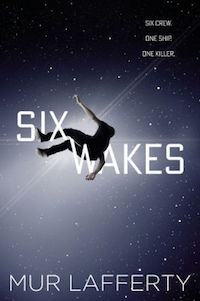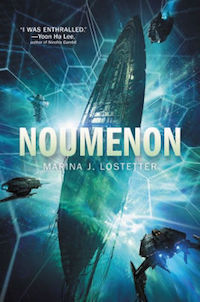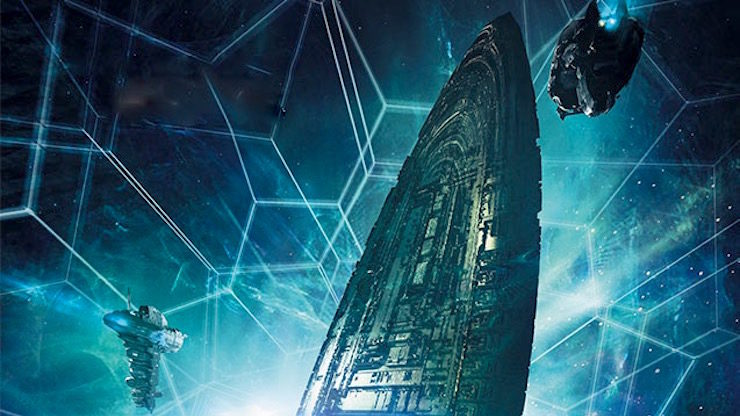What I’ve always found the most heartbreaking part of generation ship stories is the generations themselves: you’re traveling to a distant planet on a mission that will take close to a century, so you staff the ship with a crew who will pilot, navigate, make repairs, handle food stores, and give birth to offspring who will do the same, over and over again, until you reach your destination. Depending on the length of the expedition, several generations live and die surrounded by nothing but stars, giving their all to a mission whose outcome they will never witness.
Beth Revis’ A Million Suns (the middle book in her Across the Universe trilogy) sums this up in one moment: pregnant mothers taking in the devastating news that the mission has been delayed for another generation, tears in their eyes but hands on their bellies thinking of the children who will eventually get to see Centauri-Earth in their stead. Even if that’s not the part of the story that tugs your heartstrings, the temporal, generational drama is tied up in the subgenre, down to its name. Which is what makes it very interesting that two books out this year—Mur Lafferty’s Six Wakes and Marina J. Lostetter’s Noumenon—make a huge but identical change to the narrative: put clones on the generation ships instead.
Minor spoilers for both books.
It’s a deceptively simple solution for one of the biggest dilemmas of a generation ship mission: how do you control who lands on the new planet? You can cryogenically freeze the original, hand-picked team, but 150 years later you have to thaw out a bunch of people who know nothing about the changes in the universe while they were out of commission. And that’s assuming that the rest of the civilization that has grown and shifted during on board during this time even wants to unfreeze an upper class from a planet they don’t know aside from mythology, to step aside and minimize their achievements in keeping society running for generations in favor of these more “desirable” scientists and intellectuals and leaders. Instead, by crewing the ship with clones and stocking the stores with enough replacements bodies/DNA/memory banks to copy them over infinite times, the powers that be get the people they already want at the beginning and end of the mission.
It’s not as if clones have never shown up in generation ship stories before, but not in such prominent roles. George Zebrowski’s Macrolife features one young clone, John Bulero, copied from the Bulero family who unwittingly doomed Earth with their unstable material Bulerite. But his mission is not to repropagate himself in space; rather, he comes into the story after humanity has escaped a dying Earth, because he wants to try out living on a planet for a time. Similarly, Elder, one of the heroes of Revis’ series, discovers that he and every other would-be leader (Elders trained by Eldests) on the ship Godspeed are all carbon copies of one another. That series tackles the issue of reproduction and population control in increasingly sinister ways, but there’s only one strain of clones, rather than an entire team to be Xeroxed over and over.
I’ve spent a lot of this year wondering at the sudden influx of clone stories in SFF. Putting aside the convenient timing of Orphan Black’s series finale, I have to imagine it has to do with the sense of utter optimism and possibility; rather than agonize over the path not taken or a parallel universe, we can try out every potential lifetime, become our best selves. This flexibility is especially useful for an expensive, meticulously planned one-way mission.
 Lafferty and Lostetter approach their similar premises from different sides. In Six Wakes, the crew of the Dormire are all former criminals, each with a reason to hightail it off Earth and embark on a dangerous mission. Once they transfer their frozen cargo to its destination, the powers that be promise, their respective sentences will be commuted. And should they run into any fatal trouble on the way, a specially outfitted cloning bay filled with vats of freshly cloned bodies combined with regularly updated memory banks ensures what basically amounts to immortality. By contrast, the team in Noumenon is pulled from Earth’s best and brightest, the first iteration of clones trained in Iceland for a generation before stepping into the eponymous ship for a mission that will carry them out to a distant star with a mysterious blockage. Their originals will remain on Earth, never to find out in their lifetimes if their descendants—selected for their intelligence, out-of-the-box thinking, and ability to communicate with Earth—will ever actually crack the mystery of the noumenon (the opposite of phenomenon—something that exists but is unknowable by human senses). Whereas the Earth of Six Wakes, itself full of clones, has drawn up strict legal and ethical rules against any two clones living at the same time, in Noumenon there are always pairs—one old, performing their task on the ship, and one young, being trained to pick up the mantle when that clone eventually dies.
Lafferty and Lostetter approach their similar premises from different sides. In Six Wakes, the crew of the Dormire are all former criminals, each with a reason to hightail it off Earth and embark on a dangerous mission. Once they transfer their frozen cargo to its destination, the powers that be promise, their respective sentences will be commuted. And should they run into any fatal trouble on the way, a specially outfitted cloning bay filled with vats of freshly cloned bodies combined with regularly updated memory banks ensures what basically amounts to immortality. By contrast, the team in Noumenon is pulled from Earth’s best and brightest, the first iteration of clones trained in Iceland for a generation before stepping into the eponymous ship for a mission that will carry them out to a distant star with a mysterious blockage. Their originals will remain on Earth, never to find out in their lifetimes if their descendants—selected for their intelligence, out-of-the-box thinking, and ability to communicate with Earth—will ever actually crack the mystery of the noumenon (the opposite of phenomenon—something that exists but is unknowable by human senses). Whereas the Earth of Six Wakes, itself full of clones, has drawn up strict legal and ethical rules against any two clones living at the same time, in Noumenon there are always pairs—one old, performing their task on the ship, and one young, being trained to pick up the mantle when that clone eventually dies.
One team of clones attempts to atone for past sins in the hopes of earning a clean slate. The other team wants nothing more than to mark up that blank slate, again and again, exactly the same way each time.
The problem is, you can’t Xerox something over and over without the subsequent copies beginning to fade, to shift, to change. All because of a laughably obvious factor that neither version of Mission Control thought to take into consideration: nature versus nurture.
A major headscratcher of Noumenon’s planning for a centuries-long voyage is the decision to randomly assign infant clones to whatever family unit decides to petition for a child. Nor are those family units preordained: Clones of a given generation are allowed to court and partner with whomever they like, which is sweet and romantic but fails to take into account the infinite possibilities for meshing of personalities. So, already each version of Jamal, or Nika, grows up with an entirely different set of parents whose values, biases, neuroses, and experiences bear little resemblance the combination of parents responsible for the upbringing of that clone’s predecessor. Their older selves, rather than serve as parental or mentor figures, seem to intentionally distance themselves from these young clones; their interactions lack warmth or personality, and exist only to pass down the knowledge and experience that they will require once they inherit the job. And that’s not even accounting for unanticipated formative experiences, like the loss of beloved elderly mentor Diego that instills in young Jamal a worldview (in his case, shipview) that plays out generations later in a very different Jamal and Diego. Already the experiment is out of control.
Because that’s what these clones are—they’re experiments, despite Earth laws that grant them autonomy or the Planet United Consortium invoking the urgency of a modern space race to overrule ethics.
On the Dormire, clones don’t take an entire lifetime to mature; they’re grown as adults, intended to replace their former selves once they die of natural or unnatural causes. They get back however many years have elapsed since their last rebirth, but the baseline is still adulthood, shaped by the identical upbringing, morals, and knowledge that every version possesses. Though each time they add memories—the lifetime of the prior clone, the pertinent information learned thus far on the voyage, and, usually, the circumstances of their death—that build on that baseline, allowing them to learn from mistakes or develop new contexts for their continued existence. Except when those memories don’t get backed up. Then Maria Arena IV wakes up, and neither she nor her recently-murdered crewmates remember which one of them was responsible for the real-life slasher film so recent that globules of blood are still drifting in zero-G when Maria claws her way out of her cloning tank.
And it’s not as if someone whipped out a knife the moment they lifted off from Earth, either: Maria soon discovers that they are decades older than her last memory, which means a lot of blank time to be filled. Anything could have happened—accidents, petty squabbles, secrets revealed, tragedies—to have fine-tuned the tension among the crew until someone finally snapped. But even as Maria and the rest of the Dormire crew struggle to recreate the events leading up to the murders, their new selves are plagued by the inherited trauma of their past lives. The physical stressors of trying to identify the murderer mark their fresh new bodies with the emotional muscle memory of being chased and stalked and attacked, of not knowing who to trust, of watching the intensely familiar faces of their unchanging crew morph into those of strangers.
 Those same traumas exist deep under the skin for the crew of the Noumenon mission, but instead of memory banks being wiped, it’s entire genetic histories erased. Suffice to say that reaching the noumenon itself provokes a completely unexpected stressor of its own, something that derails the mission in both a literal and figurative sense. The consequences of the decisions they make upon witnessing the noumenon, decisions they could not have predicted when they first conceived of the mission, ripple down into future generations, sending the carefully calibrated clone crew into an emotional tailspin as entire clone lines are discontinued. After almost a century of the mission (nearly a millennia in Earth time) acting as a (mostly) well-oiled machine, with each clone stepping into a carefully calibrated role predetermined on a faraway Earth, suddenly there are holes in the crew and crew members who feel as disconnected as if their lines had been plucked out of the gene pool as well.
Those same traumas exist deep under the skin for the crew of the Noumenon mission, but instead of memory banks being wiped, it’s entire genetic histories erased. Suffice to say that reaching the noumenon itself provokes a completely unexpected stressor of its own, something that derails the mission in both a literal and figurative sense. The consequences of the decisions they make upon witnessing the noumenon, decisions they could not have predicted when they first conceived of the mission, ripple down into future generations, sending the carefully calibrated clone crew into an emotional tailspin as entire clone lines are discontinued. After almost a century of the mission (nearly a millennia in Earth time) acting as a (mostly) well-oiled machine, with each clone stepping into a carefully calibrated role predetermined on a faraway Earth, suddenly there are holes in the crew and crew members who feel as disconnected as if their lines had been plucked out of the gene pool as well.
It’s fascinating to see where Lostetter and Lafferty each found the story in these similar premises with incredibly different executions. Hinging Six Wakes on a murder mystery is brilliant, especially in an enclosed space and jumping ahead decades so that the reader feels just as adrift as Maria Arena IV. Though there is more sleuthing than murdering, and it felt odd that there’s no consideration given to Earth aside from the flashbacks establishing why each clone is on the ship. That latter point may have stood out to me more because of how carefully Noumenon considers just how Earth might have evolved away from the Planet United Consortium that sent out the Noumenon mission—such a thoughtful vision of future-Earth that I want to read a whole book about just it. But in that case, I found myself more intrigued by what was happening on the ground than the action in space, especially as the storytelling-through-vignettes style lacked the depth I craved. But both novels are worth a read, because they come back to the same key point.
While most of the traditional (that is, non-clone) generation-ship missions are one-way affairs with nary a look back at Earth, a number of the classic stories touch upon the cognitive dissonance as Earth’s culture branches one way and the ship’s civilization evolves away from its forebears on terra firma. With the walls of the ship the boundaries of their world and a sky full of stars instead of sun, not to mention several generations creating new belief systems and social mores, they bear almost no resemblance to the people who first stepped on that ship. Now, you would think that having a crew of clones repeat their lives over and over as they approach their destination would avoid that branching evolution, but all that that strategy achieves is to establish a number of parallel universes: These unanticipated experiences and delays and mutinies present the same characters playing out vastly different outcomes—trodding every path not taken, but rarely becoming, as hoped for above, our “best” selves.
Clones aren’t the fix, because you can’t expect them to go through time and space unchanged. There are not enough rules or failsafes to account for what happens on a generations-long space voyage, because we’ve never undertaken one. Not even preserving the same genetic code and the (mostly) same conditions can ensure that the person who boards the ship on Earth will resemble the person who steps onto a new planet for the first time. The mysteries of space are too much for humans, even the most optimized or genetically engineered or handpicked ones. We must adapt to whatever is out in the black.
Natalie Zutter can’t wait to see other authors start tinkering with this new sub-sub genre of “clones on generation ships” and find different stories to tell. Talk generation ship space travel with her on Twitter!










